More than thirty-five years after their inception, frequent flyer programs (FFPs) still capture the imagination of customers and industry practitioners. Many industry observers considered FFPs a bit of a gimmick originally, but they turned out to be one of the most successful marketing programs of the airline industry over time. Programs not only continue to grow (in most markets) and evolve, but they also play an increasingly important financial role for airlines. For North American airlines, the loyalty contribution (revenue attributable to members of that airline’s loyalty program) can easily reach more than 50 percent. This chapter provides a comprehensive overview of the history of FFPs, and will address the question why FFPs are still relevant in today’s world.
History of Frequent Flyer Programs
When President Carter signed the Airline Deregulation Act on October 24, 1978, it paved the way for significant growth, and, much stronger competition. In May 1981, American Airlines launched the AAdvantage program.1 The original idea to create a FFP came from someone outside the airline industry. Bill Bernbach , CEO of Doyle Dane Bernbach (DDB), an advertising agency at the time for American Airlines, is credited with coming up with the original idea (Petersen 2001). The original idea was quite simple: reward high-frequency customers with a free ticket once they reached a certain threshold. The idea itself was not entirely new, for example the United Airlines ’ Executive Air Travel program and American Airlines’ American Traveler served a similar purpose. Historically, FFPs can also be traced back to Southwest Airlines’ 1970s scheme of giving ‘sweetheart stamps’ for bookings, which would allow the business traveler to collect benefits in order to take a partner on a free flight (Gilbert 1996). The concept of “rewarding” customers for their loyalty was an adaptation of a system that had already been used by the hotel industry during the 1970s (Mason and Barker 1996). But two major changes in the regulatory and technological environment around 1978 essentially created a new and conducive environment for FFPs. The first change was the deregulation of the US air transport passenger market. Until that point in time, airfares (but also routes, and market entry by a new airline) were set centrally by the Civil Aeronautics Board which had done so since 1938. The second change was very much linked to the first change. With the increase in competition, and the newly gained ability to set their own fares, airlines became increasingly reliant on advanced reservation systems. Newer, more sophisticated systems effectively allowed the airlines to track passenger transactional behavior and run the first frequent flyer programs. The computer reservation system allowed American Airlines to compile a database of its “frequent flyers” and awarded them bonuses—including free round-trip tickets and free upgrades from economy to first class—for flying a minimum number of miles per year (Lederman 2007). Within two months of American Airlines announcing their program, Braniff, United Airlines, Continental and TWA had all declared their offerings. Continental’s “Flightbank Program ” was seen as being critically important to the future development of FFPs by their inclusion of bonus points for travel booked with a Carte Blanche credit card (Mason and Barker 1996).
When FFPs were first introduced in 1981, many observers both in- and outside the industry considered the programs to be a marketing “gimmick”, and only of limited strategic importance. But, by 1986 it had become apparent that the FFP was an important key to the competitive viability of an airline (Levine 1986). By the end of 1986, 24 out of 27 US carriers had devised similar programs (Gilbert 1996). It turned out to be the biggest and most successful innovative marketing program in the history of the airline industry (Browne et al. 1995).
Overview of Key Events
Since their inception in 1981, programs have continued to evolve. Arguably the most critical changes were introduced relatively early in the life of FFPs: elite tiers, partnerships (both in 1982) and co-branded credit cards (in 1986). The list below outlines notable events in the history of FFPs.
1980.Western Airlines introduces a USD 50 discount voucher for passengers who had completed five flights on its program sowing the seeds for a later frequency marketing programs.
1981. American Airlines , United Airlines and Delta Air Lines launch their respective FFPs.
1982. American Airlines introduces a Gold tier to the AAdvantage program. The tier is designed as an incentive for frequent travelers to consolidate their spend...
